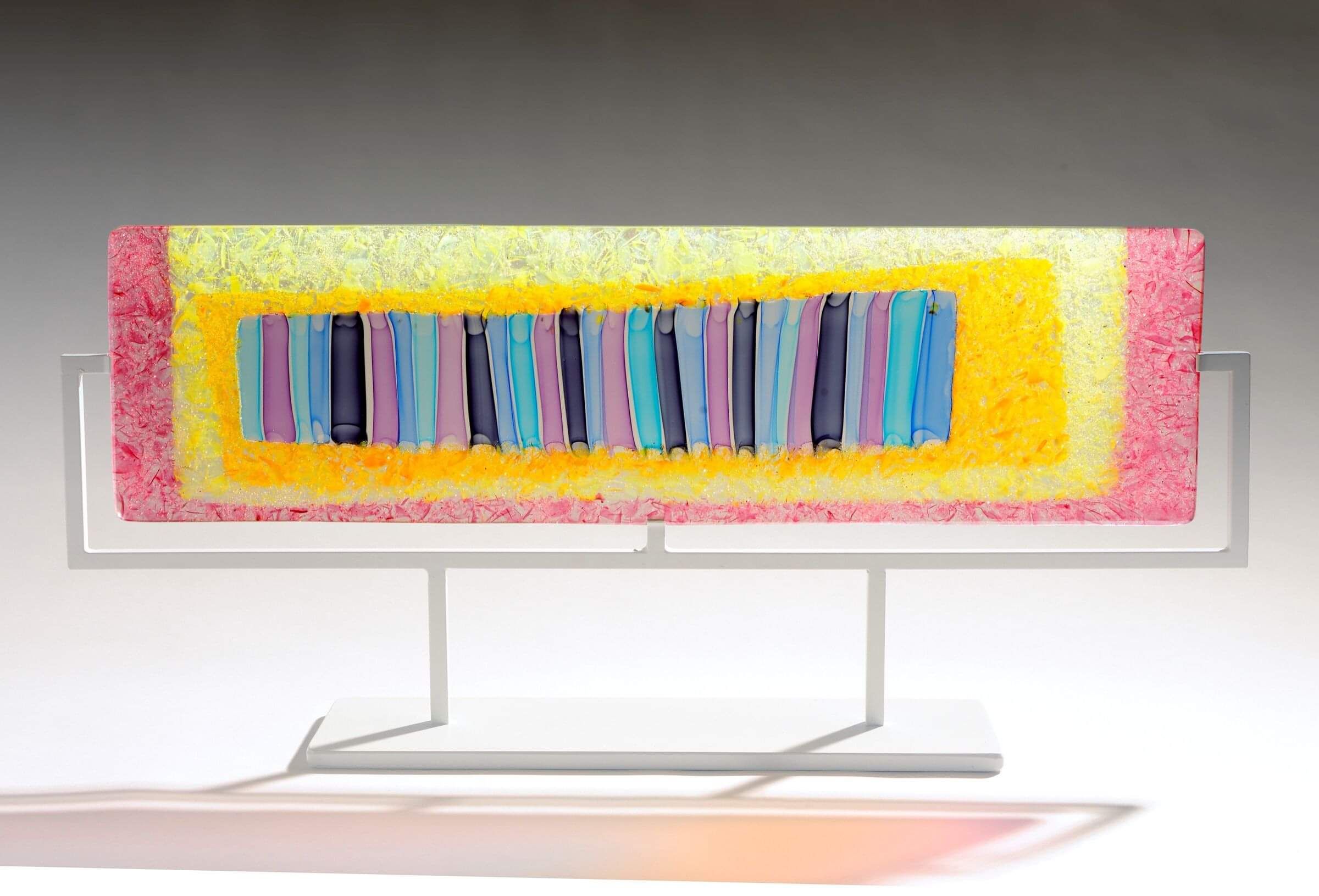
GLASS ART 2021
Curated by Amy Taunt
26 February to 21 March 2021 MAIN GALLERY
Glass Art 2021 celebrates the wonderful world of glass art, its many forms and iterations and using a myriad of techniques.
More than 30 works from this country’s top glass artists, in a variety of glass techniques, including kiln-forming, casting, blowing, flame-working, and other specialized techniques, will be exhibited.
Exhibition work includes pieces from Justin Culina, Carmen Simmonds, Karin Barr, David Traub, Claire Bell, Richard Landers, Philip Stokes, Graeme Hitchcock, Jenny McLeod, Lynden Over, Carmen Simmonds and Paul Burgham.
Image: David Traub, Meteor, Hot glass components, fused and cold worked in powder coated steel frame
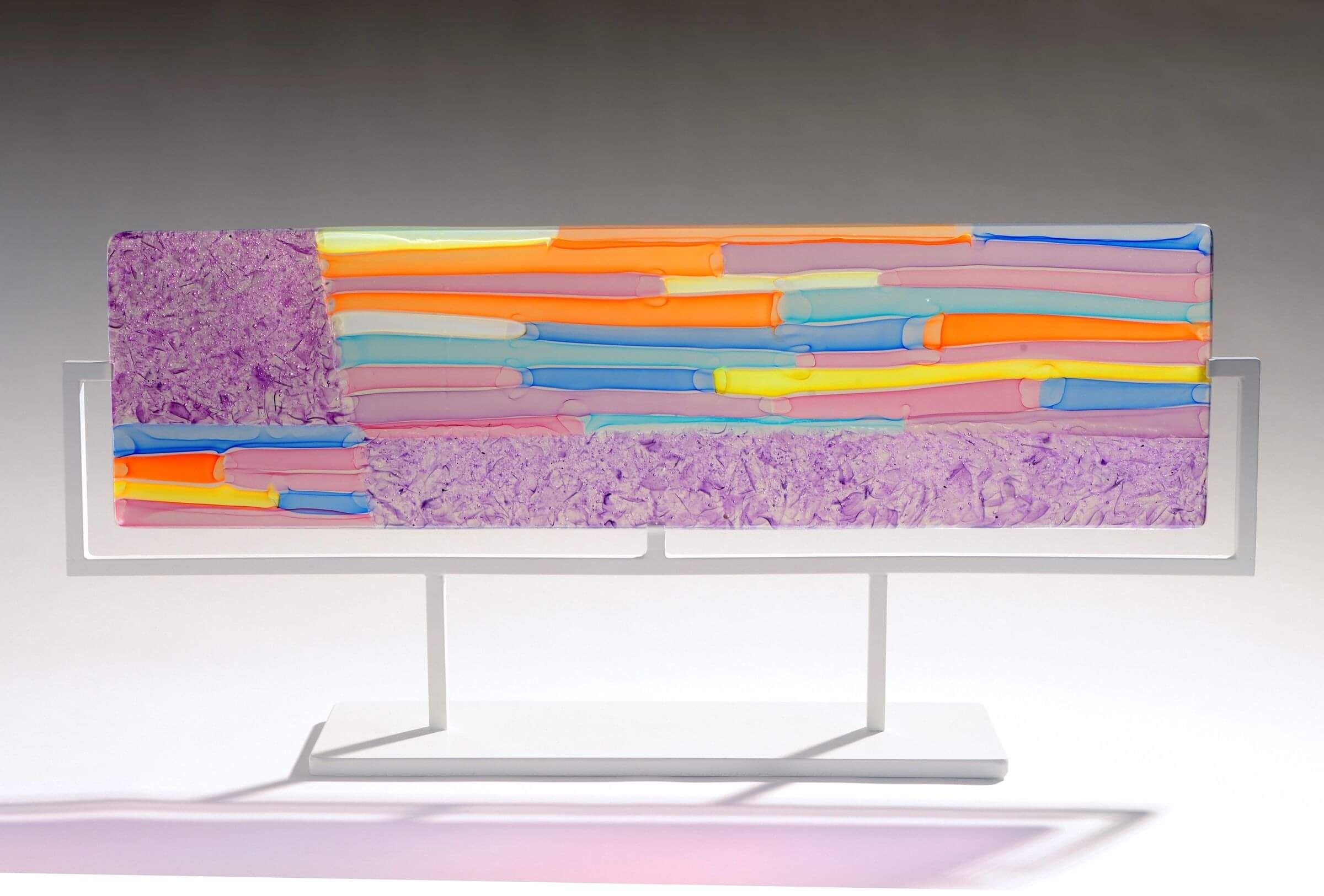
David Traub
Tectonic
Hot glass components, fused and cold worked in powder coated steel frame—$2500
Stretching the boundaries of glass, colour and abstraction; Traub’s passion for glass has spanned a career of 45 years which has seen his work exhibited around the world and selected for numerous publications. His work is informed by several things; taking inspiration from the Abstract Expressionist painters from the 1950’s and 60’s and equally inspired by textile art and quilt-making. The quiltmakers of Gee’s Bend in Mississippi and traditional wrapping cloths from Korea have been helping him in his exploration and development of recent work. Using multiple techniques such as blown hot glass and kiln processes like fusing and slumping, Traub creates collectable platters and freestanding works inspired by painting, textiles and architecture.
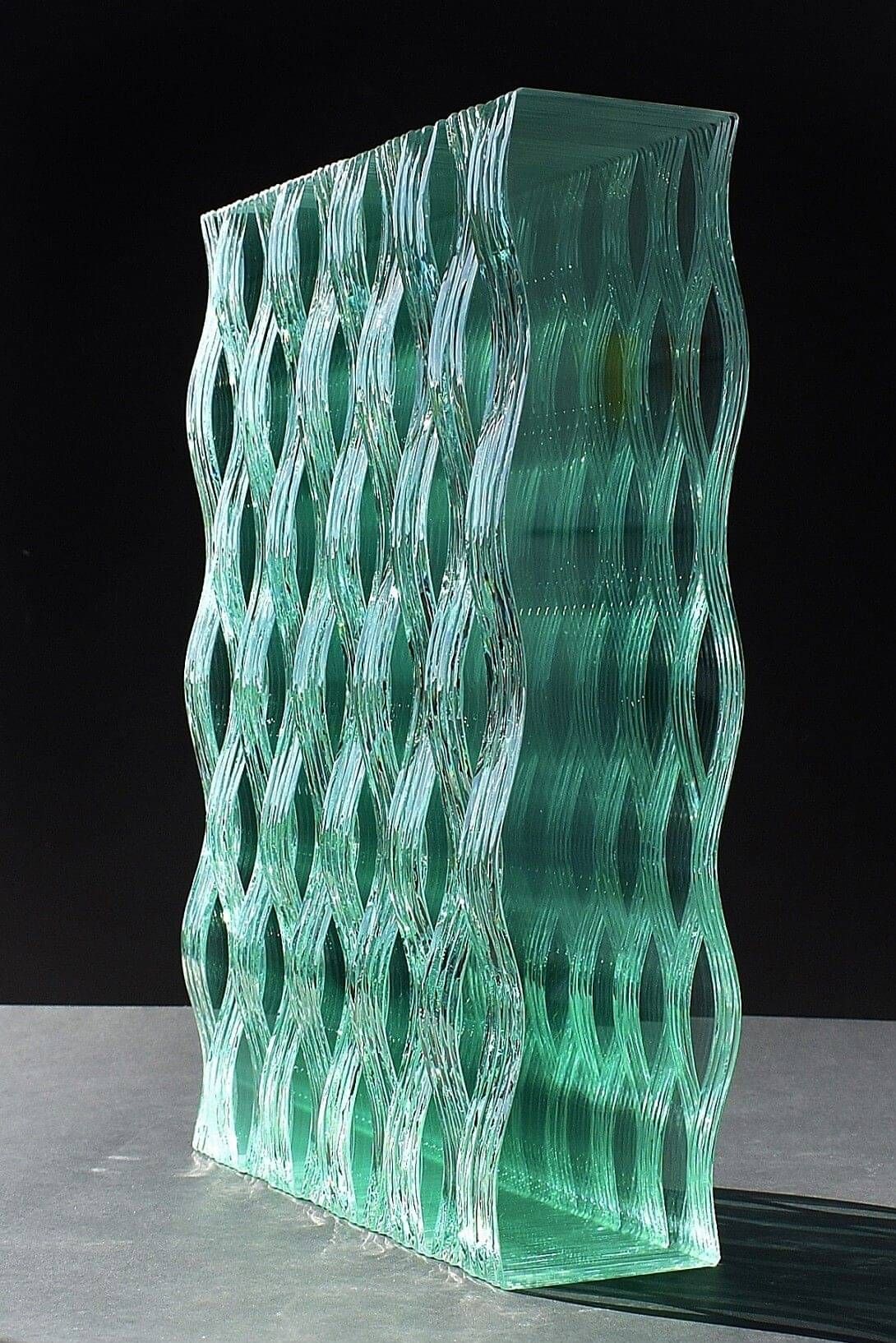
Richard Landers
Interwoven
Laminated window glass—$3200
From concept through to finished piece, each step is done by hand with meticulous attention to quality and detail; the architectural space and important personal details make Landers' work special and individual. Each work brings its own challenge – one that drives his passion for art and design. And, while the scale of each project may shift, from residential to corporate facilities, churches to maraes, galleries and public spaces, each is bound by unwavering craftsmanship, thought and considered detail.
Richard’s work is created by multiple laminated layers of float glass. The light bends and refracts through the layers letting the reflection play on surrounding surfaces. Richard is based in New Plymouth where the mountain is a prominent feature of the landscape.
‘I am constantly amused, exploring, and exposing the effects of ‘glass on light and the reward of ‘curiosity’.
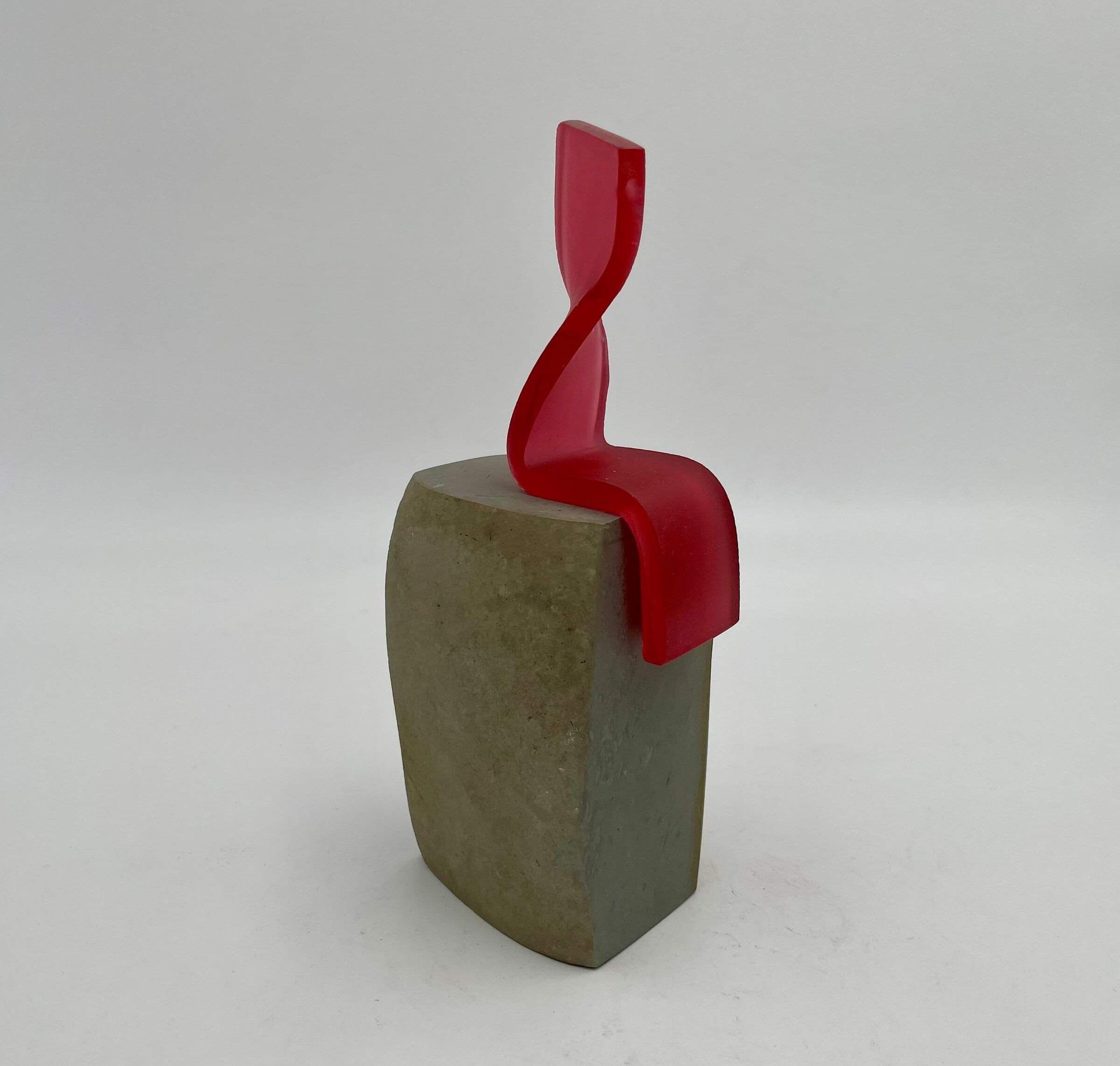
Karin Barr
Observer II
Cast glass on stone—$340
German born Barr qualified and worked as a Medical Lab Technologist before she arrived in the rural Waikato NZ in 1994. In 2003 she had the opportunity to take part in the Matamata Sculpture Symposium and discovered her passion for carving stone. Eager to learn more about other sculptural media Barr learned the craft of glass-casting using the lost wax method. Over the coming years she attended national and international Master classes to extend her knowledge in sculptural glass making. Karin’s work is held in the Wallace Arts Trust and other private collections nationally and internationally.
‘The unique qualities of glass as a sculptural medium allow me to bring contrast with colour and the use of light in my pieces. I like working with simple forms, mixing and matching with playful concepts. Most of my works show clear and strong lines and are influenced by the Bauhaus Movement. My installations are often a response to different sites and environmental concerns.’

Philip Stokes
Marmaron
Blown glass—$1200
Philip is one of Australasia's leading contemporary glass artists and now spends his time between Melbourne Australia and New Zealand, refining, expanding and exploring the craft of glass.‘Making large-scale works is exactly like a choreographed dance where the ensemble of glass artists works as one to create expressive, movement suggestive sculptural works in hot glass.’ Stokes architectural sculptures and installations can be found in the lobby of the Four Seasons Hotel in Hong Kong, and the Sheraton Hotel in Xiamen, China amongst many others.
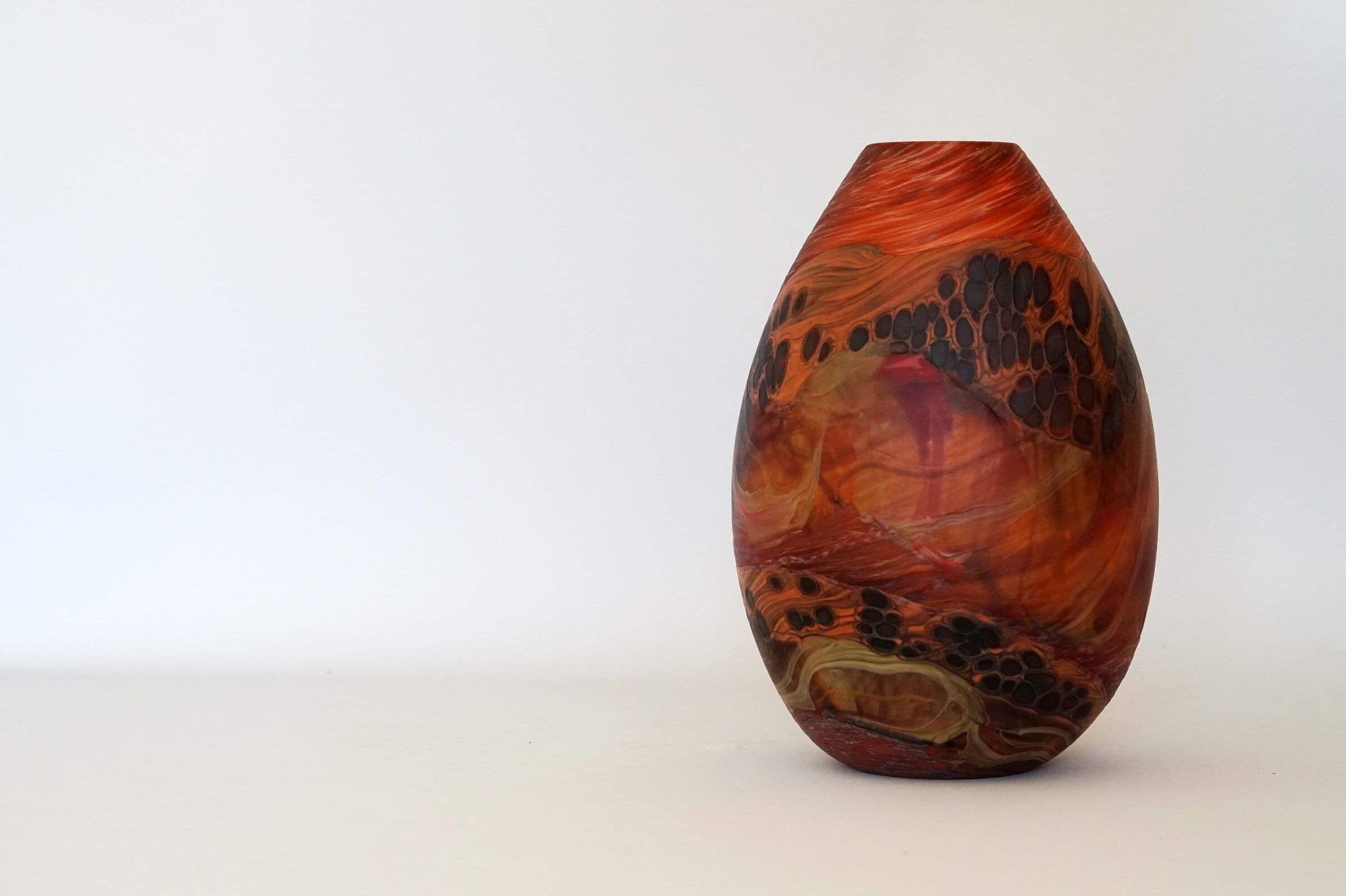
Lynden Over
Desert Road
Hand-blown glass—$1550
Lynden Over is the world-renowned award-winning New Zealand glass artist behind Lava Glass in Taupo. His style is striking and unusual. His inspiration comes from the distinctive and dramatic New Zealand landscape; its geology and its light. The work itself awakening our senses.
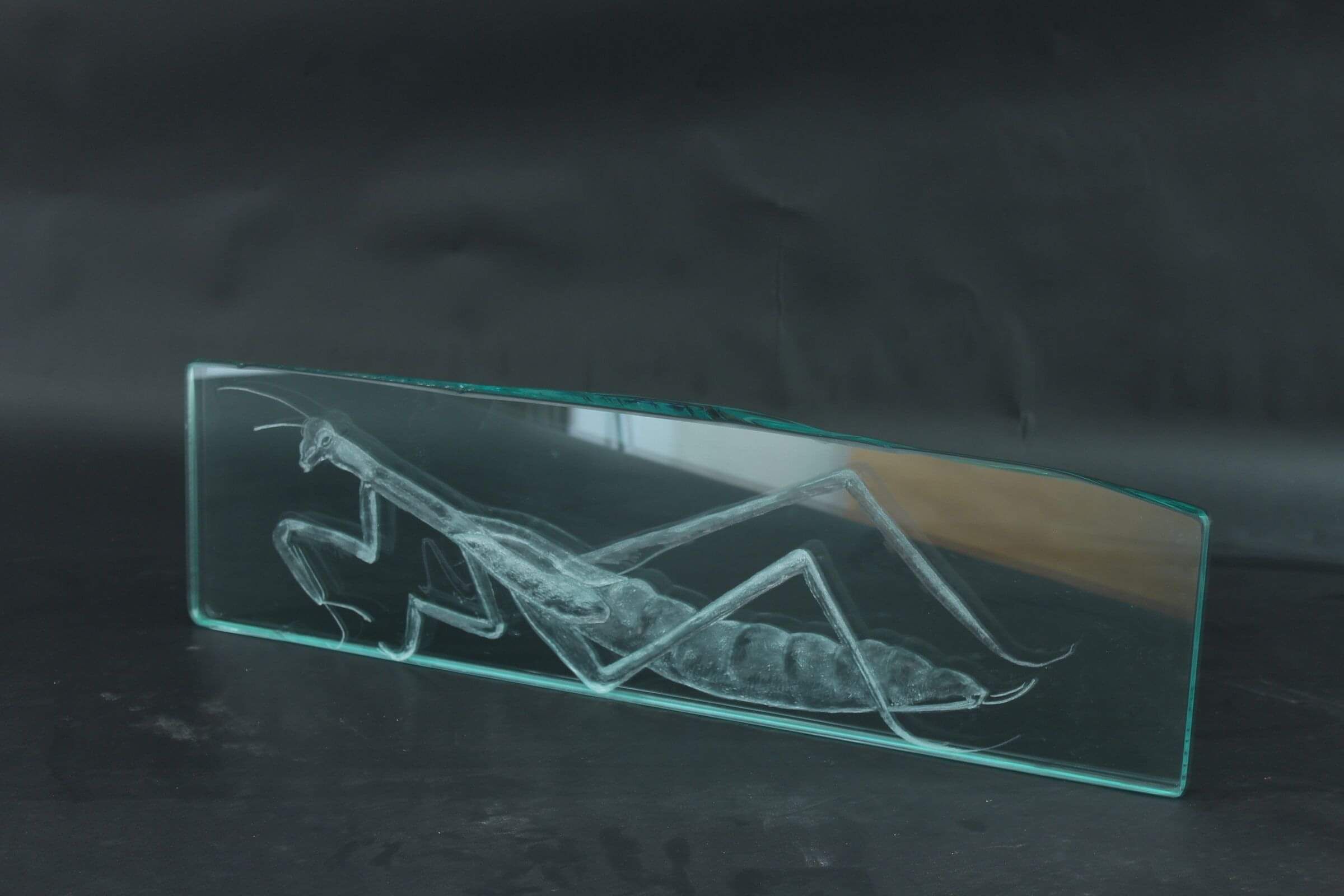
Claire Bell
Illicit Witness
Engraved Glass—$1200
Exploring image and creation of space through mark making is at the heart of her practice, with a focus on translating these onto glass through engraving its surface. Currently Claire works with clear or tinted float (window) glass to do this, using the techniques pioneered by John Hutton to create work based on her drawings.
‘Engraving transparent glass hovers in a space between the second and third dimension, as neither drawing nor sculpture. This enables me to explore presentation options, which include silvering the engraving to become an engraved mirror, wall-hung box framing or freestanding it in space. Each option opens up ways to question the perception of the image and the object, exploring its relationship with viewer and surrounding environment.’
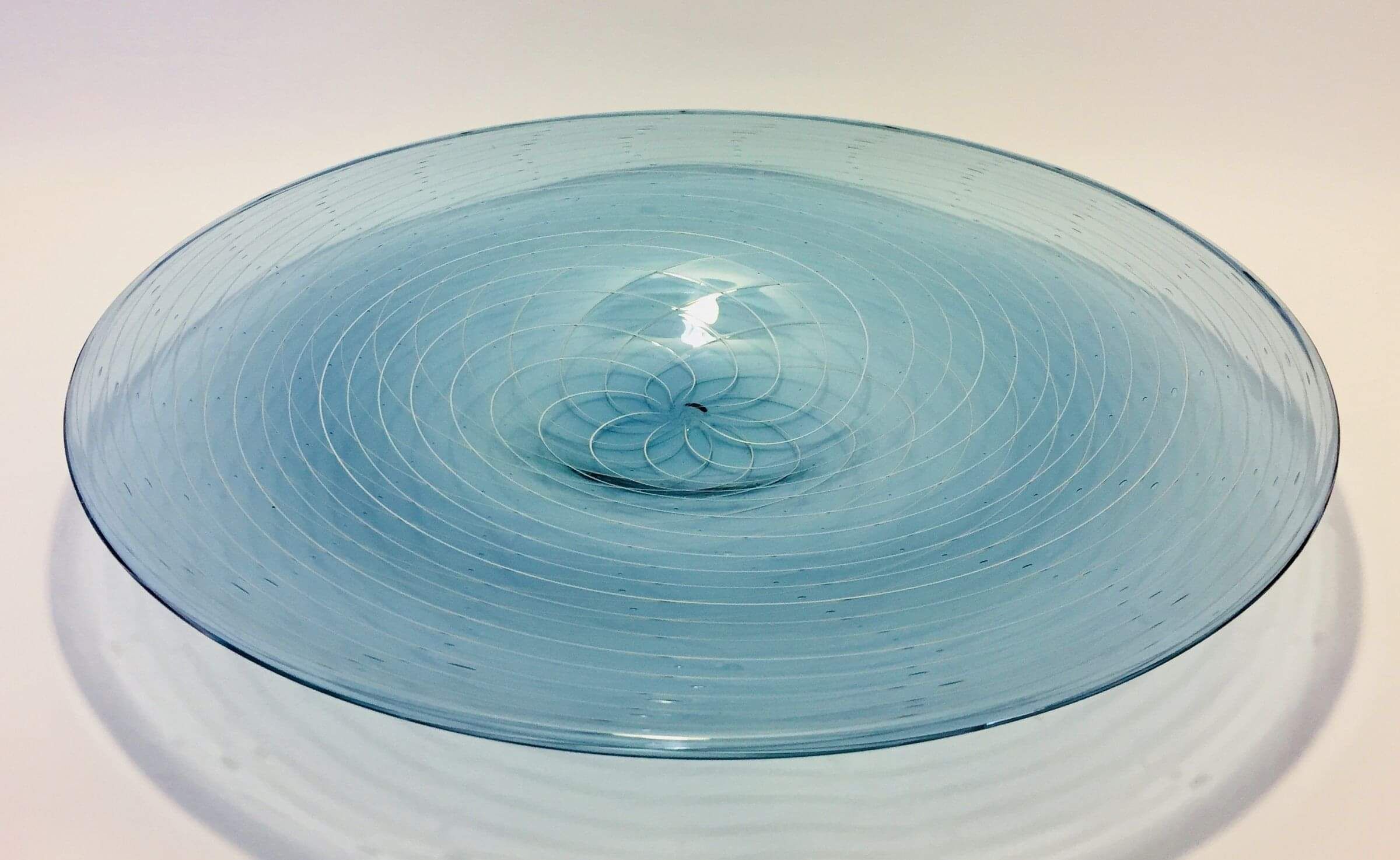
Justin Culina
Kupenga Platter
Blown glass—$600
From a ridge in Parua Bay, Northland, Justin Culina works overlooking the ocean. In this context he finds endless inspiration for his fine art glass works. Culina’s portfolio ranges from ocean-inspired bowl forms, to complex vases, intricate platters and utilitarian drinkware.
At the core of Justin Culina’s practise is a concern for incorporating ancient glass techniques in a contemporary manner. He first spent a number of years developing a skill-set in techniques such as cane roll-ups, murine, incalmo, filigree and latticino. Now, with these techniques at his fingertips, he is able to push his designs in new and exciting ways.

Jenny McLeod
Crushed Blue
Fused blue glass—$400
Jenny gained a Diploma with Distinction at Carrington Polytechnic in Auckland, New Zealand, studying Craft and Design. She set up her first kiln studio at home after receiving a QEII Arts Council New Artist Grant. Fusing glass, she slumps, cuts and layers it - in her now renowned original designs.
Building on her glass work using mixed media materials, she has taken her art outdoors, creating larger garden sculptures and installations.
‘NZ is not only a country of natural beauty, but it is a country rich in cultural diversity. These are constant reference points in my work, which is created with a Pacific inspiration, for a modern setting.’

Paul Burgham
Volcano
Cast concrete and stained glass—$1230
Eltham-based, Paul has developed a passion for stained glass windows and lamps, which he says has occupied him for the last 20 years. The design and construction of lamps is a lengthy process, and he makes, on average, two per year, fitting this around his other creative work, commissions and repair jobs. Nature’s authentic patterns often play a part in Paul’s creations; beautifully formed flowers, and forms such as paua shells. Paul has also carried out a number of commissioned works, recently completing new stained glass windows in the Sacred Heart Girls College's chapel in New Plymouth.
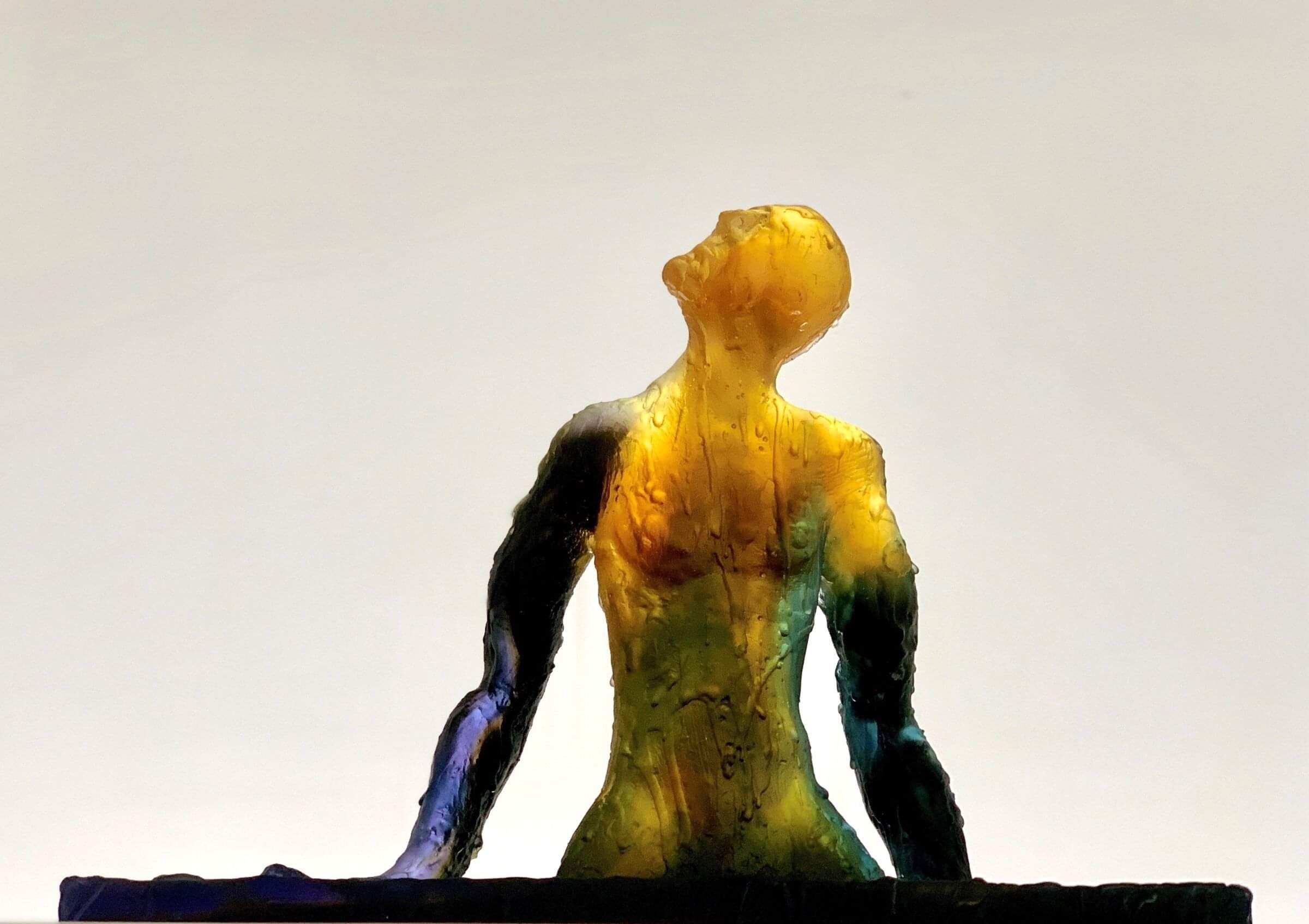
Graeme Hitchcock
Emergence
Cast glass (gaffer lead crystal)—$1850
Graeme is a sculptor and painter based in Wellington. He creates figurative sculptures in cast glass and bronze.
It wasn't until age 40 that Hitchcock began seriously exploring painting in oils and creating sculptures in glass and bronze. However, he had a rapid positive response to his work and quickly developed a strong portfolio with the figure at the centre. Depicting the figure is continually alluring to the artist, for the ability the subject has to communicate a range of emotion. Hitchcock enjoys exploring the full spectrum of human feeling from intense joy, through to sadness and loss, sometimes also depicting conflicting and mixed emotions.
Hitchcock has become well known for his ‘Man Looking’ collection which depicts men with tipped heads and upward facing noses, often dressed in conventional black suits. Hitchcock developed the idea after seeing a group of men waiting at a bus stop in Auckland, who had their hands in their pockets, looking up as they waited to catch the bus to another day of work. Along with the whimsy of the figure's expressions, these pieces are cast in a range of vibrant colours, which adds a playful contrast to the suited subject.

Carmen Simmonds
The Decision
Cast glass, blown glass, copper and bronze—$2600
Carmen is currently working in cast glass and mixed media from her rural studio in Whanganui.
Carmen's practice has evolved from early explorations of women's dress, into defining the 'specific techniques', such as crochet, used by women to create dress. Her current work examines how these traditional making processes can be drawn upon and visually remembered within the creation of her sculptural glass objects
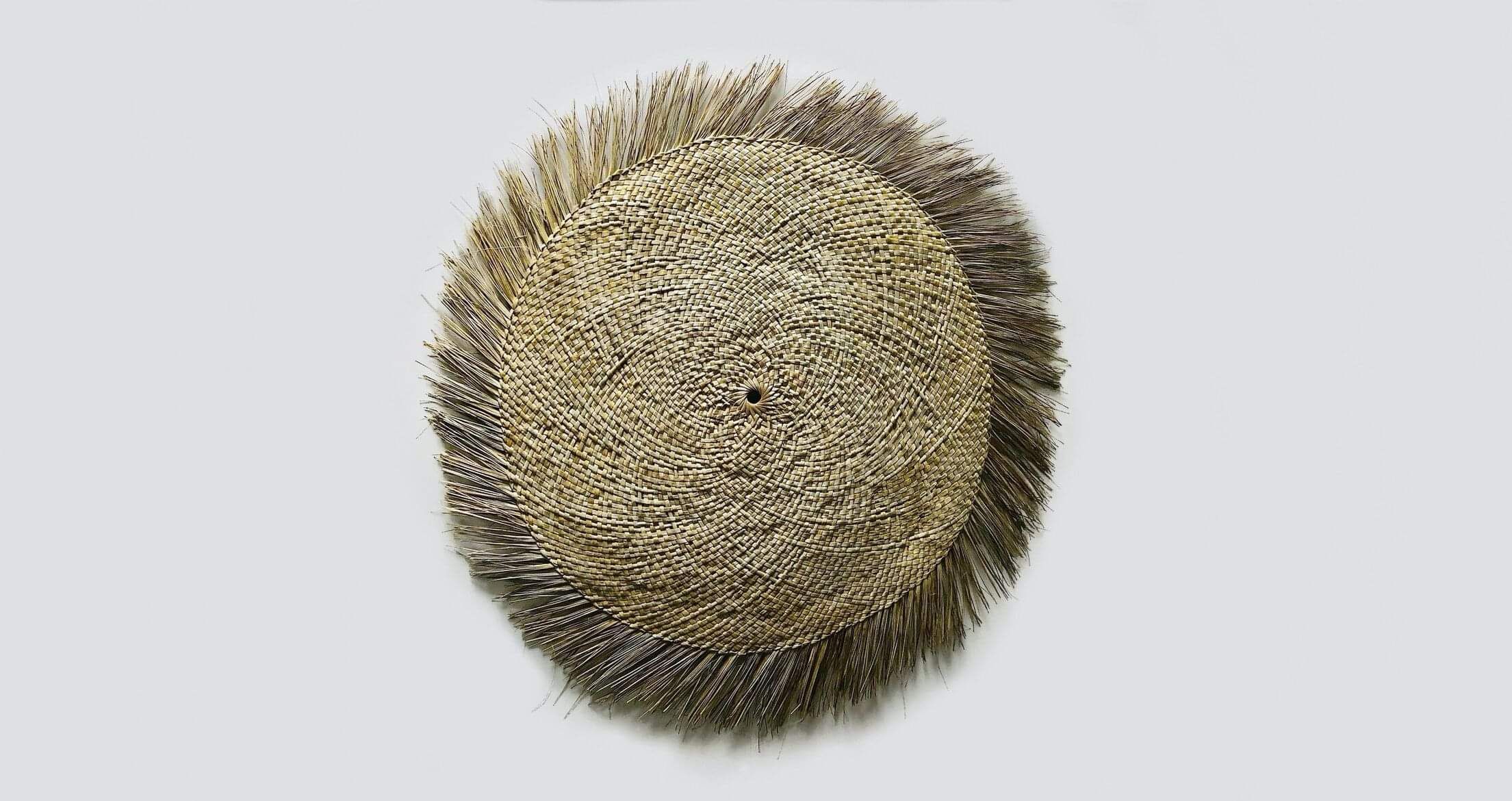
RARANGA
HARAKEKE
Bernadette Ross
26 February to 21 March 2021 MAIN GALLERY
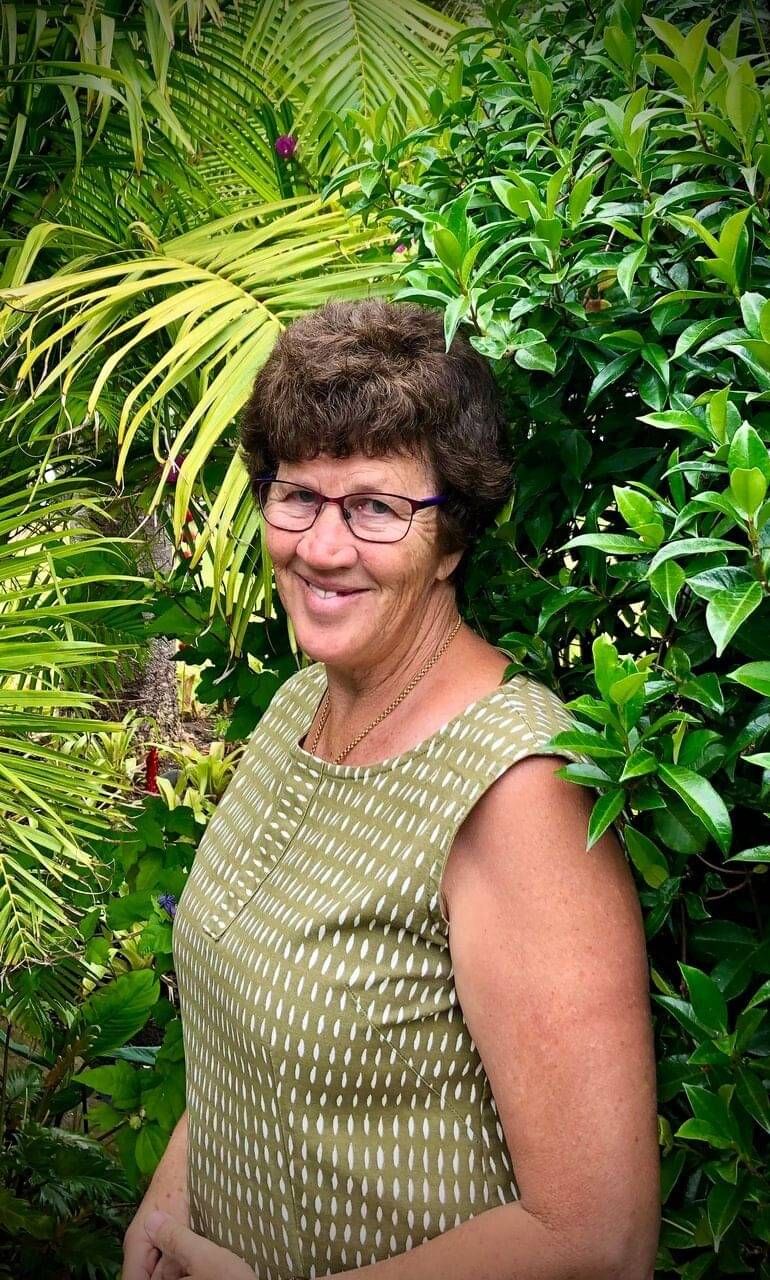
'As a raranga artist, harakeke is the medium I use for the majority of my work. Its versatility, ease of use and the connection it provides to our Whenua, makes it a pleasure to work with, both in a physical and spiritual sense...'
Bernie connects with the Whenua with her large colourful works. You see the bright blues and greens of the sea and sky, the golds and browns of the earth and the glorious greens of the land.
Bernie was born in South Auckland on a dairy farm, one of nine siblings. Growing up on the farm taught her huge respect for the land, the bush, the rivers and sea. These early experiences led her to a landscape gardening career. She lived living in England working in landscaping before returning to New Zealand in 2002. A physical injury at 50 necessitated a change of direction and subsequent enrolment into Te Wananga o Aoteroa.
‘What followed was four wonderful years of learning the art of raranga (flax weaving).’
The influence of raranga tutor Bibbins Tangitu is clear. Bibbins was a master of Porohita and Kete. While doing her Maunga Kura Toi -Bachelor of Maori Art, she was guided by the skilful weaver Rawhinnia Gray.
Bernie won the Harcourts Art Challenge in January 2020, and the Wearable Art Aoteroa section in Coromandel in 2014. In 2019 she was involved in the Star Waka installation for the Tuia Celebrations in Whitianga.
‘As a raranga artist, harakeke is the medium I use for the majority of my work. Its versatility, ease of use and the connection it provides to our Whenua, makes it a pleasure to work with, both in a physical and spiritual sense. The environment surrounding me in Whangamata; the bush, sea, beach and farmland and their colours, textures, sounds and smells provide inspiration for my work. I continue to be challenged to reflect what I see and feel around me and express this in the work I produce.’

Bernadette Ross
Rimurimu
Harakeke and Teri Dyes—$570
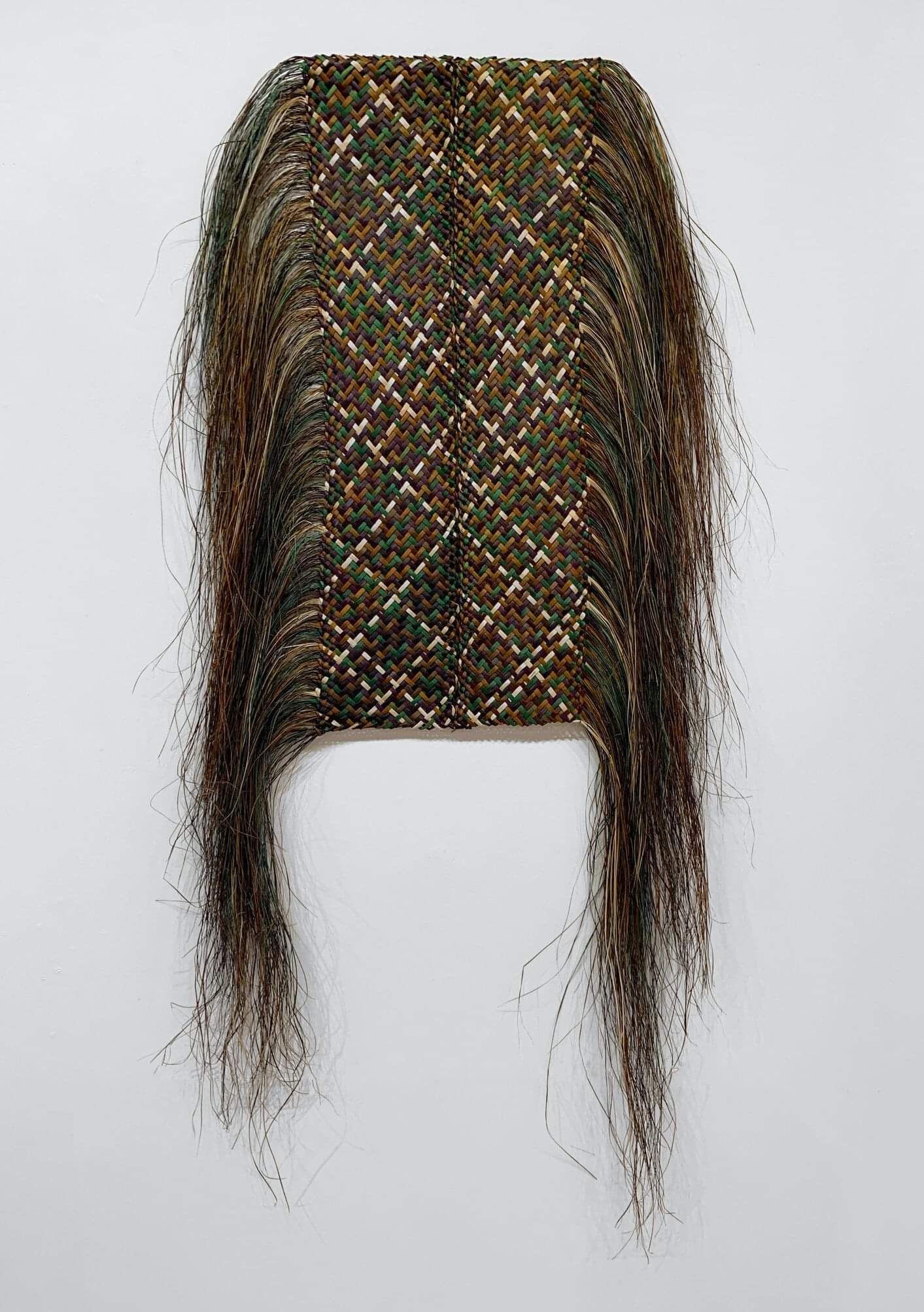
Bernadette Ross
Papa Ngahere
Harakeke and Teri Dyes - $970
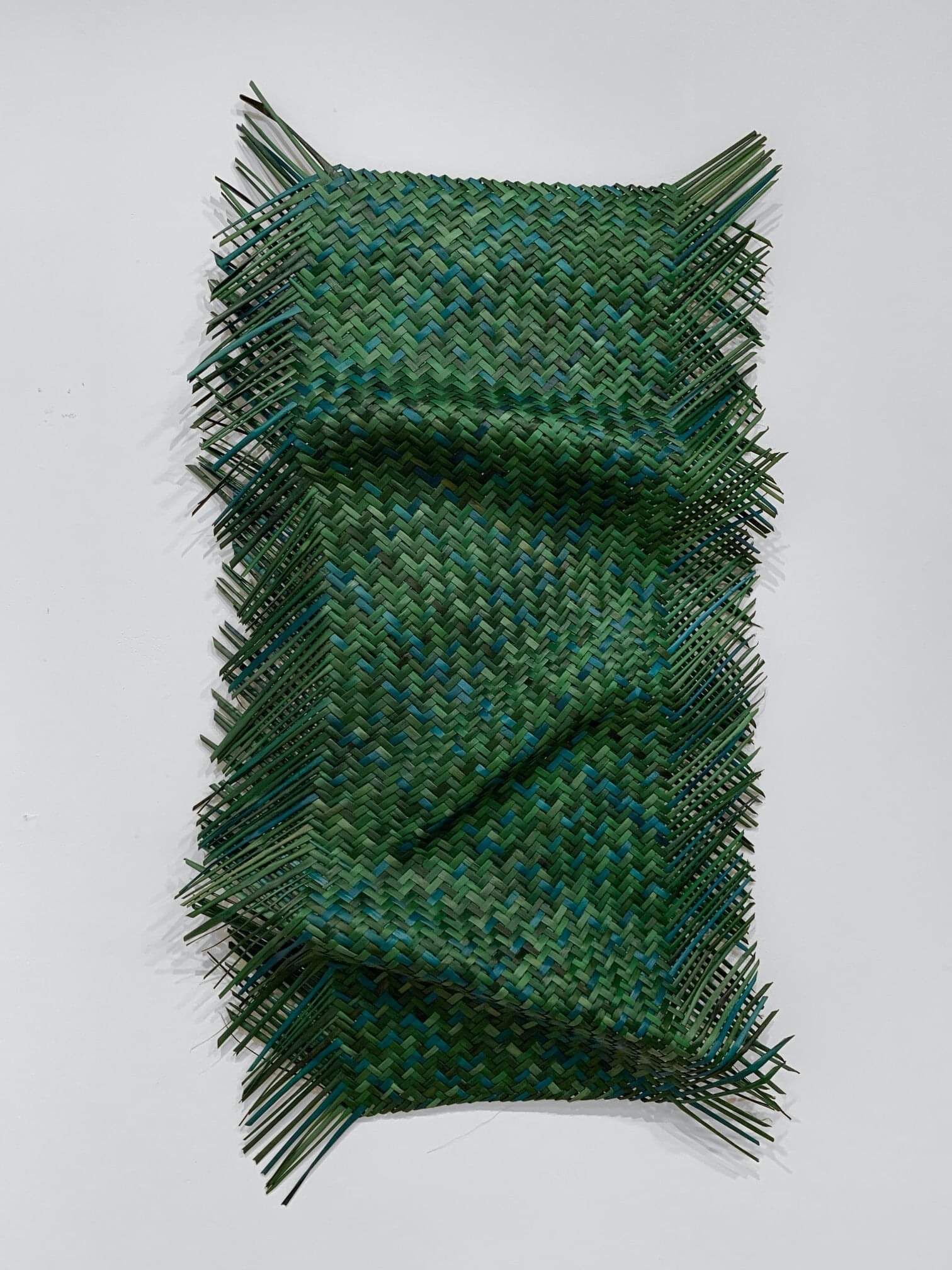
Paddocks in Winter
Harakeke and Teri Dyes - $570

Bernadette Ross
Ngahere
Harakeke and Teri Dyes—$970
For three weeks of every year Puawhanga flowers in the bush

Bernadette Ross
Hatu Patu’s Rock of Refuge
Harakeke and Teri Dyes—$970
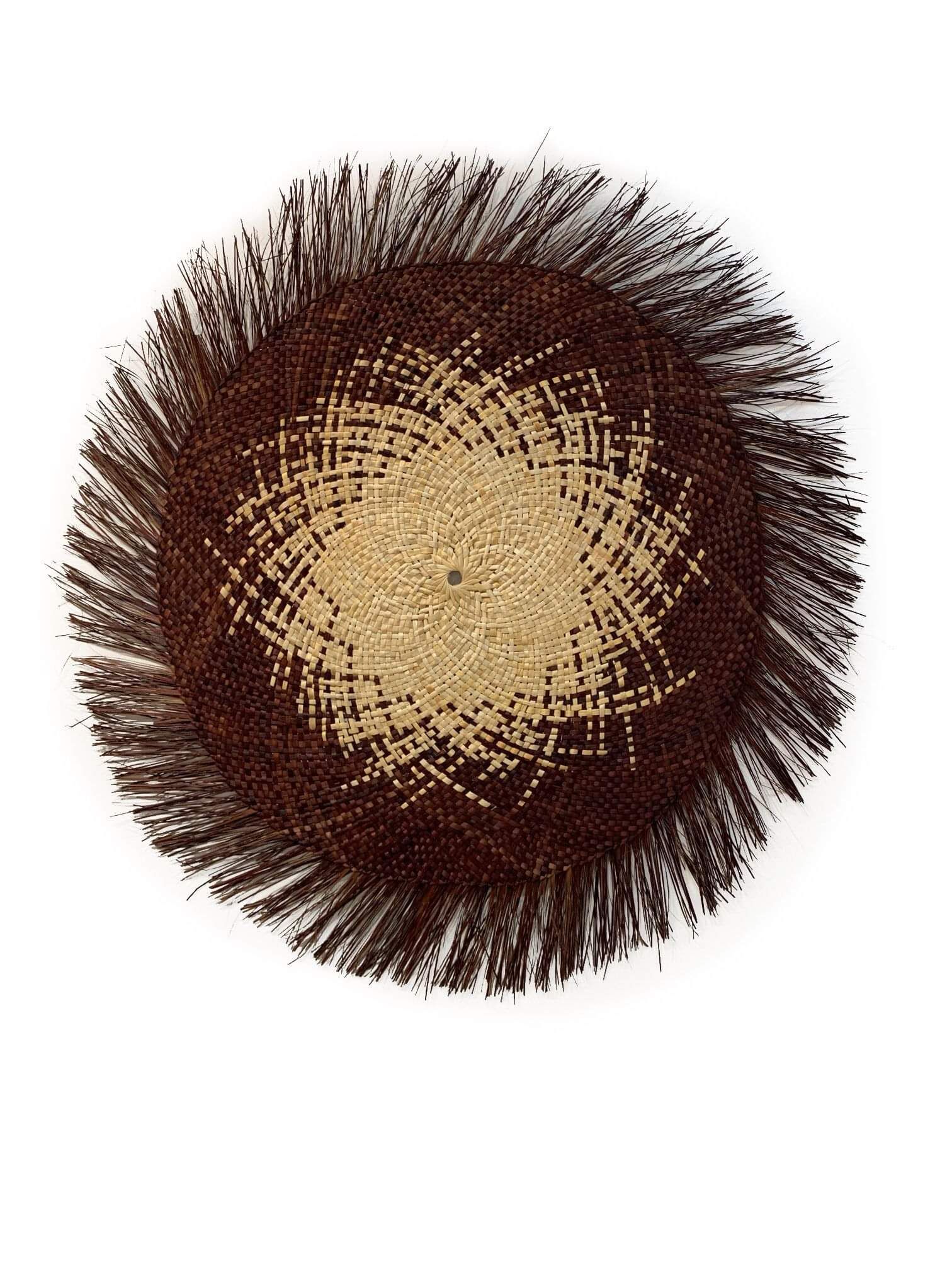
Tussock
Harakeke and Teri Dyes—$970
This porohita was inspired by the colour of mountain grasses.
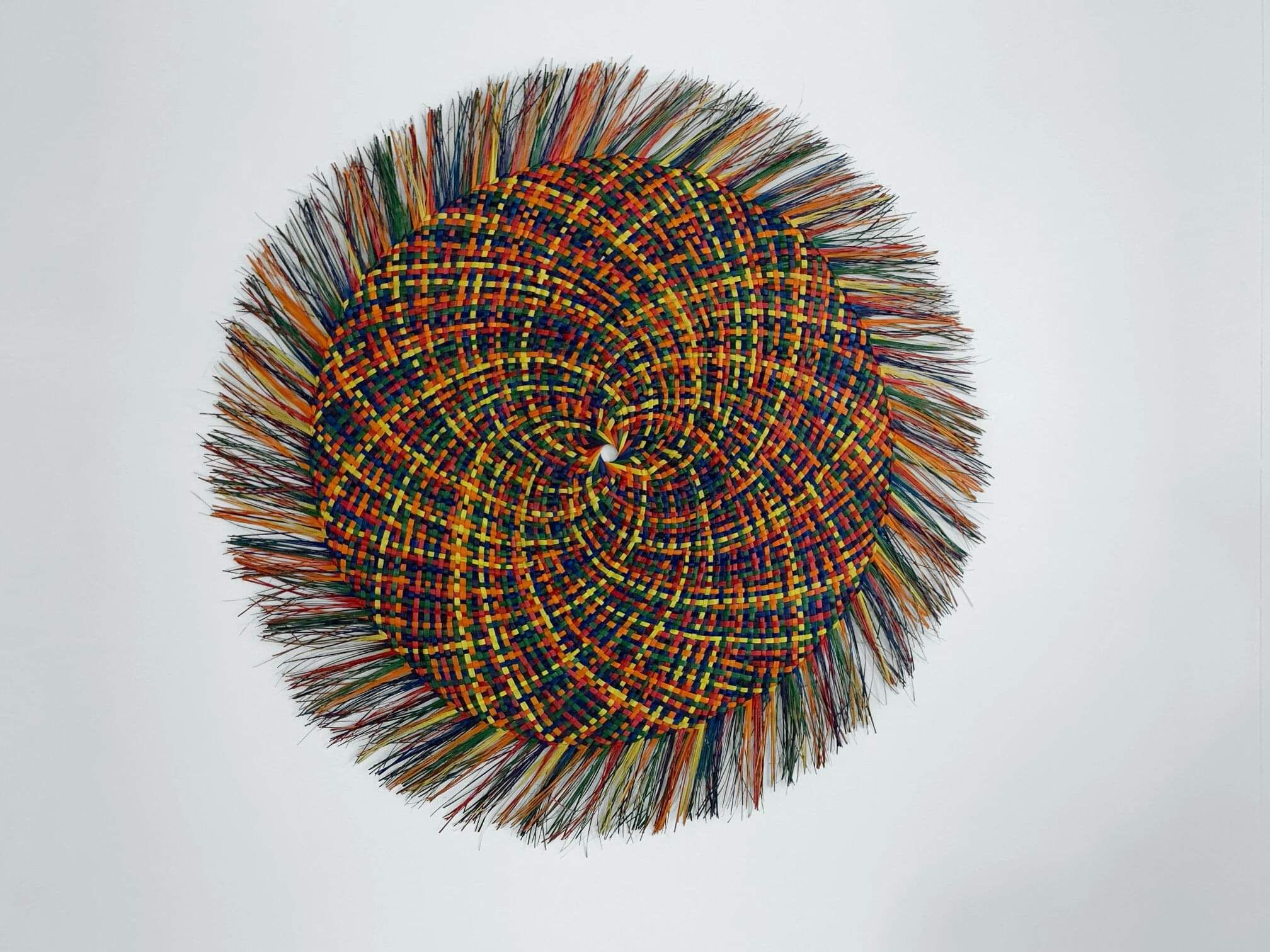
Bernadette Ross
Kahukura
Harakeke and Teri Dyes—$970
Take a second look
a SOLO EXHIBITION by TEXTILE ARTIST
Jennifer Patterson
26 February to 21 March 2021 GALLERY 2
Jennifer Patterson began her love affair with textiles and design when she attended a meeting of the newly-formed Stratford Village Quilters group in the mid-90s.
Jennifer’s twin sister, Jeanette Gillies, was already an established nationally-recognised quilter and it would appear Jennifer definitely had the ‘gene’.
That was the beginning of long journey which lead to her developing her own style and fabric printing process for her bespoke designs. Three years ago she exhibited in an exhibition in Australia, which speaks volumes of how far she has come since the first quilt she stitched together more than 20 years ago.
Jennifer’s passion lies with art wall quilts, executed with silk, dyes and ‘rusted’ fabrics. Lots of trial and error has assisted her to come to a recipe that works best.
Leaves are used for her botanical prints on silk and paper, and on other fabric.
Her contemporary works are often embellished with beads, wool and embroidery threads.
Jennifer is also well-known for her beautiful hand-dyed scarves.
Jennifer Patterson
Street Lights
Textiles—$160
Black silk organza has been rusted and the beading and stitch lines are representative of streets lit up at night in two townships. The wooden beads link the townships together and it is finished off with beaded trails on each side.

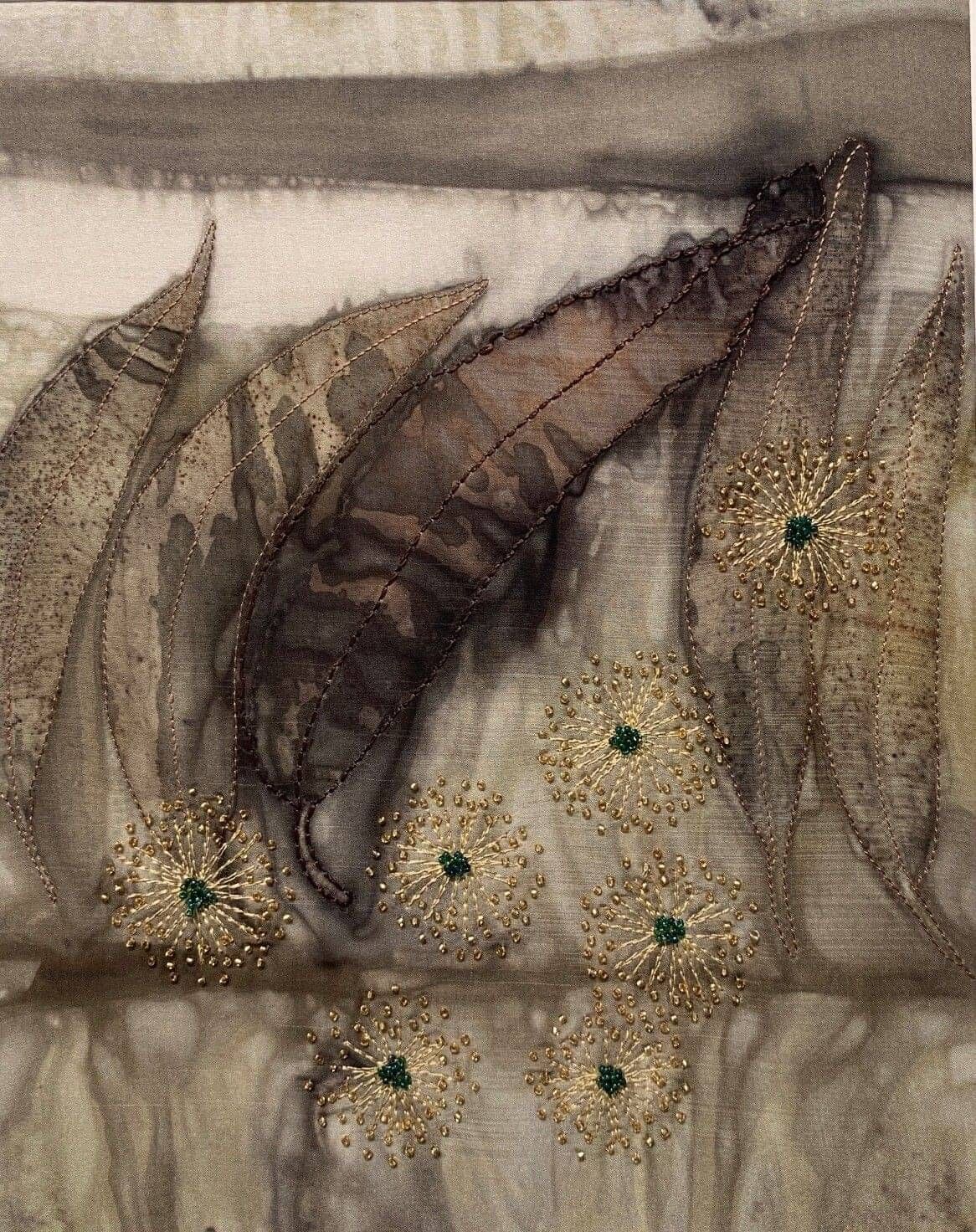
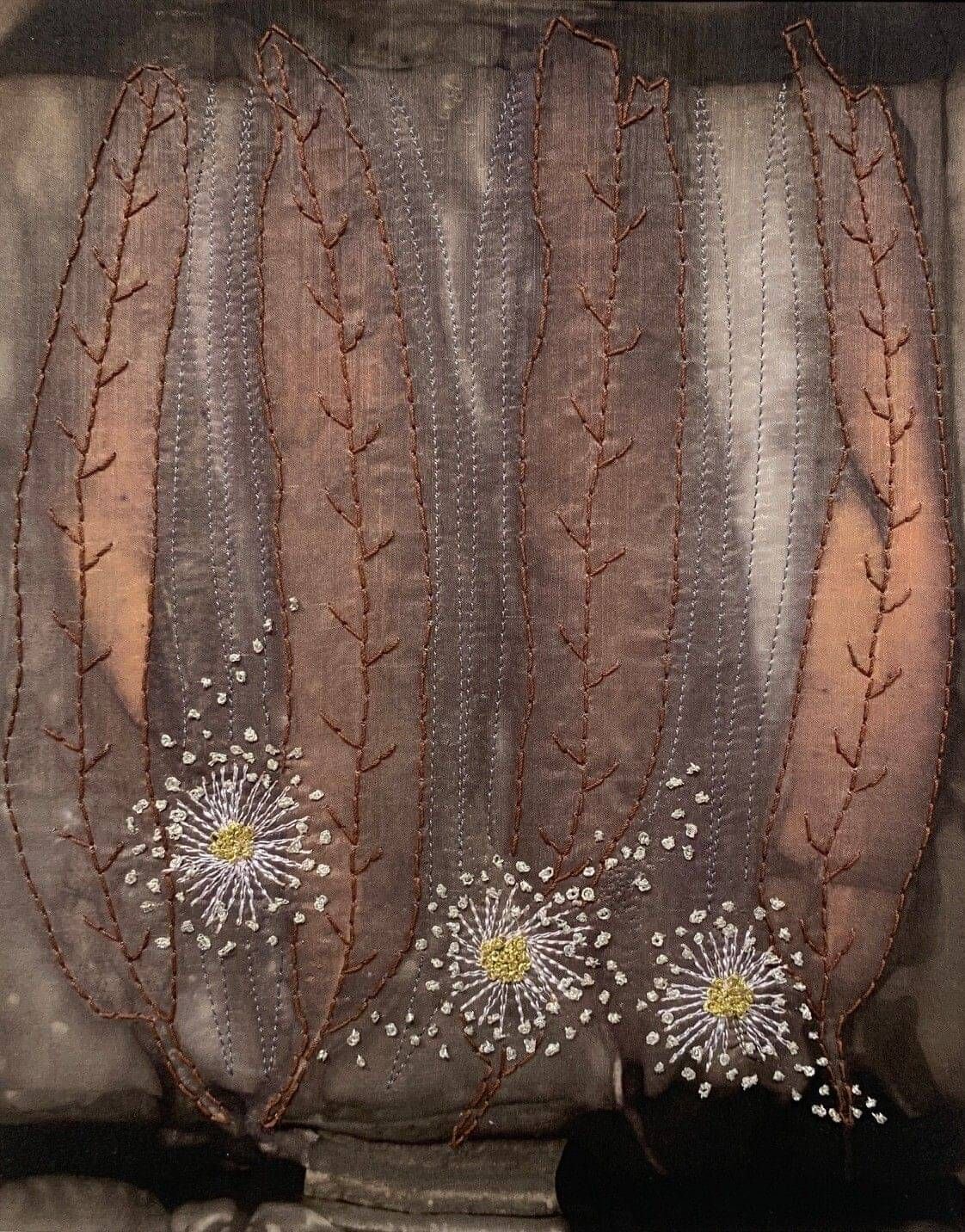
Jennifer Patterson
Framed Botanical Dyed Gum Prints
(1, 2, and 3 of six) Gum prints—$160 each
The gum leaf image has been transferred onto the silk and stitched to outline the shape. Some are embellished with embroidery stitch or beads. They are then framed out with a neutral mounting to enhance the natural colours within.
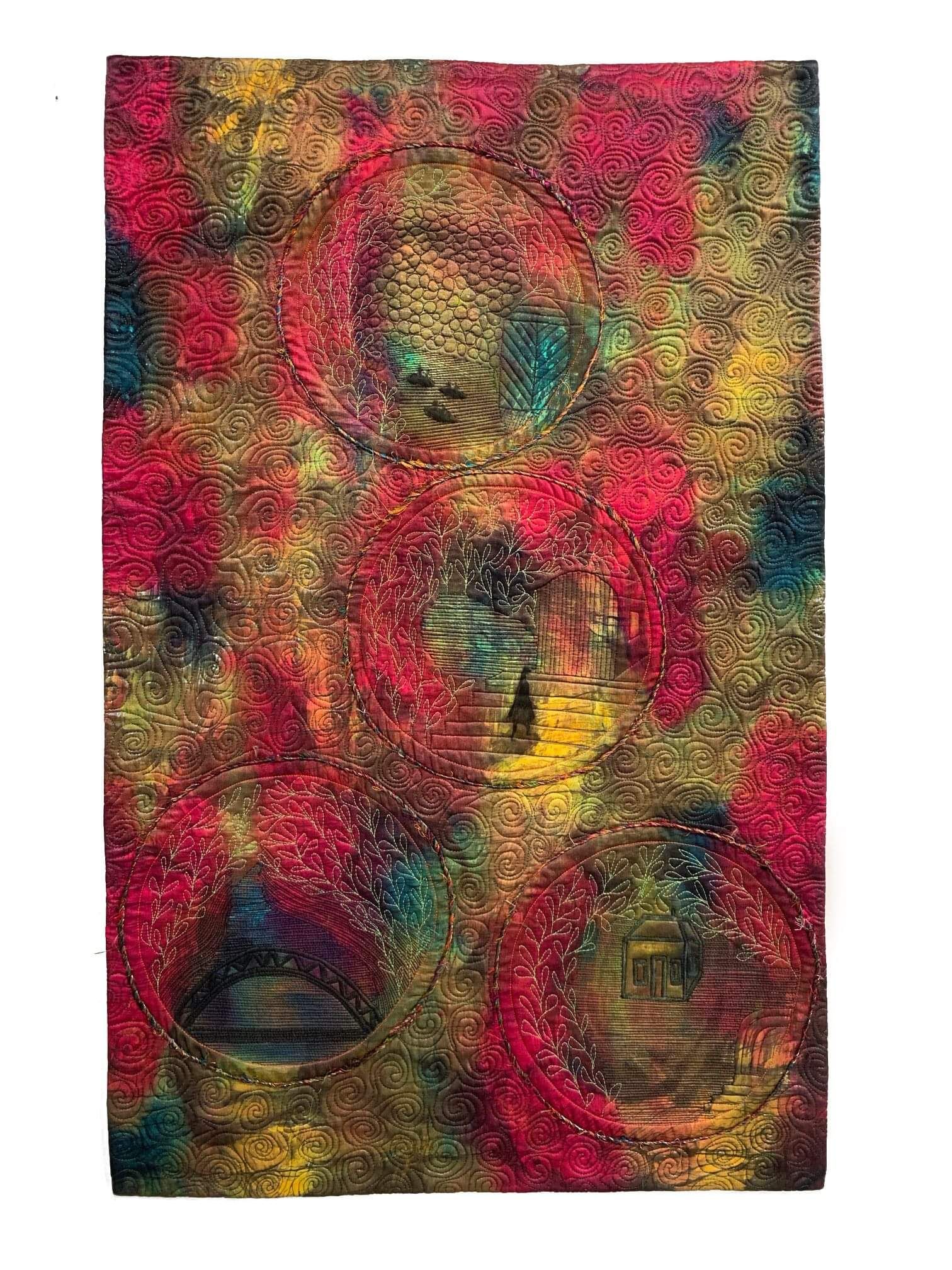
Jennifer Patterson
At the Park
Textiles—$300
The dyed fabric had soy wax brushed on in a circular motion and was then overdyed. The four pictorial areas were marked out and the background stitched. Each area was carefully chosen using the markings on the fabric and an extra feature was designed and added to depict a scenic area of a park. The areas have been edged with spun silk threads from Nepal.
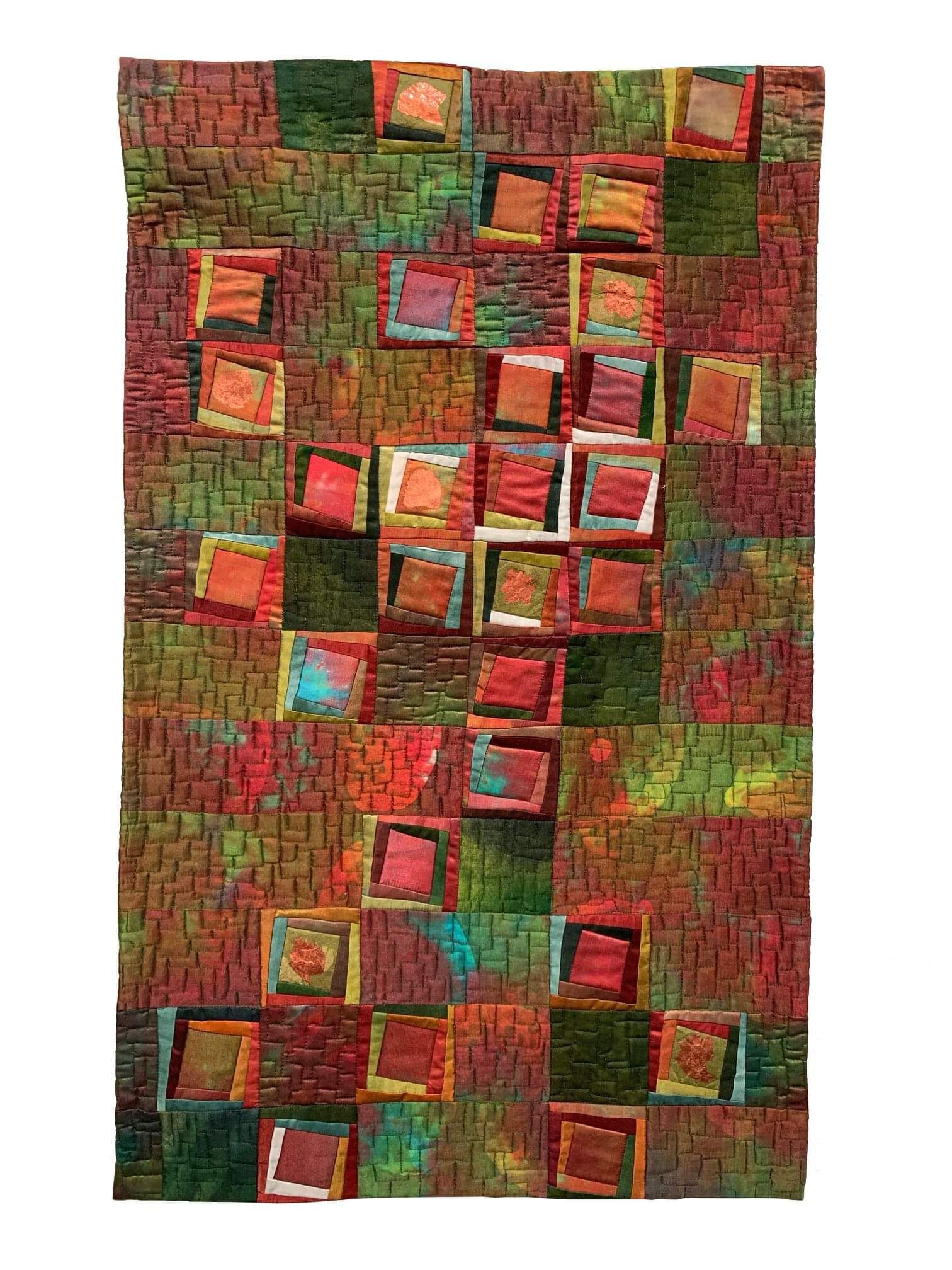
Town plan
Textiles—$300
Bright colours were already on the fabric before the soy wax was applied and it was over-dyed with a darker green. The pieced squares have been interspaced with strips of batik fabric at various intervals giving a ‘town plan’ look. Some pieced squares have copper foil to give interest.

Jennifer Patterson
Faultline
Textiles—$300
The original dyed fabric was a darker hue and when the soy wax was applied and over-dyed it had a distinct geographical look. The close stitching allows the land mass to become more realistic, hence the faultline evolved. Gold foil over a strip of organza gives it prominence.
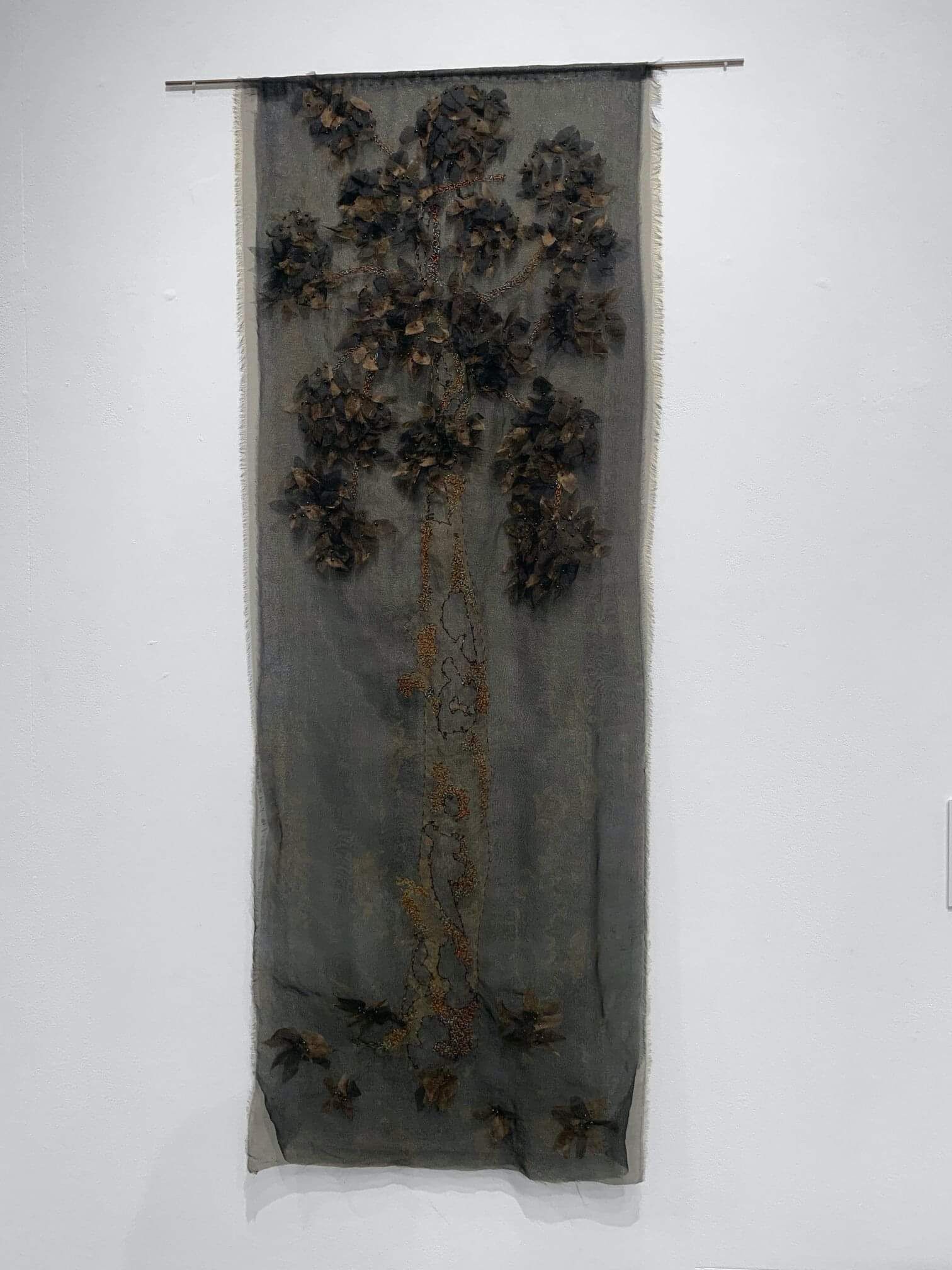
The Tree
Textiles—$300
Rusted markings on the black silk organza left an impression of a tree with a strong trunk. The trunk was embroidered with seed stitch and French knots. The tree top had many leaves cut out and attached with beads to give a living 3 dimensional effect. It has been backed with a grey polyester organza to bring out the detail.
